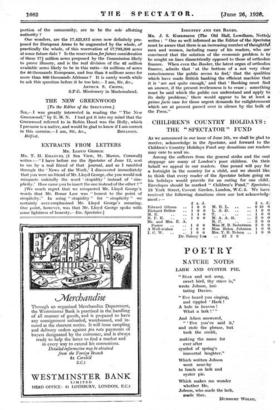THE SOUTHERN RHODESIAN LAND COM- MISSION'S RECOMMENDATION OF SEGRE- '
GATION AREAS [To the Editor of the SPECTATOR.] Sul,--7-A brief summary of this Land Commission's Report has been already given in the Manchester Guardian of April 1st. Many criticisms of the .recommendations in it may be reasonably urged : one main criticism is obvious, and is given here. The Native Land-Purchaser is not getting a fair quid pro quo under the Commission's recommendations. In paragraph 89 the Commission speaks of Europeans in Southern Rhodesia not having fully realized " the fact that the native has in law the same rights to acquire land as they have, and that when the reserves. were set aside there was no intention whatever of depriving him of that right, and that if he giVes up the right to acquire land anywhere he must secure in return-a real* quid pro quo." The commission's Table of Land in Southern Rhodesia in Appendix II On page 40 gives these details of how much land there is in the colony- " Alienated Land 31,486,095 acres ; Native Reserves, 21,203,498 acres ; Unalienated, 43,529,880 acres." How does the Commission propose to divide, roughly speaking, this 431 million acres of available unalienated land between the European settlers and the indigenous natives of Southern Rhodesia.? The answer is that the Europeans are to have nearly 171 million acres definitely allotted to them at once for their Purchase Areas. The maximum amount of the Native Purchase Areas recommended by the Commission is considerably less than half that amount which is recommended for future European purchase. [See Paragraphs 206 and 207.1 The new census arranged to be taken in Southern Rhodesia in April of this year may show the European population to be about 40,000: the Native population is estimated on page 19 of the Commission's Report at 818,947: the ratio of Native population to European may be guessed then as 20 to 1.
We have the Commission's word for it that —" The majority of the Natives who have expressed an opinion upon the subject. and of the missionaries who have spoken for them, consider that the land should be divided equally. . . ." [See Paragraph 81.] Is that 431 million acres of unalienated land divided either equally or equitably under the Commission's recom- mendations ?
Although it is recommended that the Native's present rights to purchase land anywhere in the Colony be reformed away at once, while 17 millions and more of acres of land are to be assigned at once for European Areas, and less than half that amount for Native Areas, the Commission recommends that another 17t million acres of land be reserved for future consideration. [See Paragraphs 100-116 of the Report.] Now when once the present right of the Native to purchase land anywhere be safely repealed, how many of those 17,793,300 acres that arc to be left unallotted are likely to be allotted to Native Areas—if the local Legislative Assembly's members, who, as the Commission notes in Paragraph 76 " to all intents and purposes, have been elected " by the white portion of the community, are to be the sole allotting authority ?
One wonders, are the 17,423,815 acres now definitely pro- posed for European Areas to be augmented by the whole, or practically the whole, of this reservation of 17,793,300 acres at some future date ? Is the reservation for future consideration of these 171 million acres proposed by the Commission likely to prove illusory, and is the real division of the 43 million available acres likely to be in this ratio-34 millions of acres for 40 thousands Europeans, and less than 8 millions acres for more than 800 thousands Africans ? It is surely worth while to ask this question before it be too late.—I am, Sir, &c.,
ARTHUR S. CRIPPS, S.P.G. Missionary in Mashonaland.











































 Previous page
Previous page